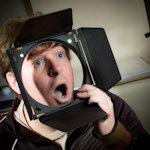Going Out In The Rain
Wed
5 Nov 2014
5 Nov 2014
As we get into November, you may look out of the window, and seeing the terrible weather, decide that you won't be going out with your camera for some weeks. Rain is pretty miserable, but that doesn't mean that any photographs taken on rainy days will be bad ones. You just have to think of the rain the way you would think about any other object in the scene. It's impossible to ignore it, it makes it harder to use your camera, and as a subject it is less 'traditionally' pretty than sunshine, but it has a certain photogenic quality of its own.

1/250 sec, f/5 @ ISO400 - 59mm
Moving into urban areas, wet surfaces become reflective, which gives you something extra to play with when trying to come up with interesting compositions. Cities lit up at night in particular look good when photographed in the rain with lights reflected in the street surface.
When it's raining, the rain itself becomes part of the subject; what might otherwise be scene where nothing much is happening can tell more of a story when photographed in the rain. People will react to rain and this can add to the story; examples include people using umbrellas, running and covering themselves, or jumping in puddles and making light of the weather. Think also about the mood that rain imparts to the image; most people associate rain with misery and depression, so you could go out and try to capture this feeling, or alternatively you could try and show a lighter side to it.
It is typically darker on rainy days, so you will need to compensate for this; bumping up the ISO can be a good tactic to use, you get a bit more leeway as the noise this introduces will be less of a problem if there are speckles of rain in the image anyway. A shorter shutter speed will ensure that raindrops appear on the image, as you lengthen the exposure beyond about 1/60 (depends on focal length) drops become longer and fainter streaks before disappearing altogether. You can get decent results with an aperture of f/4 and a shutter speed of 1/250, and then adjust the ISO depending on available light.
A circular polarising filter can be used in the rain, particularly when photographing vegetation if you want to get that lush green look. It will have a similar effect on other surfaces however it will also reduce the brightness of reflections, which you may not want. If you want the reflections then remove the filter as you will gain about a stop of exposure without it.
If you get drops of water on the lens, then these will show on the photograph, and can cause lens flare, so keeping your lens' front element (or filter) dry is important. If you have one, use a lens hood, and take a lens cloth or microfibre cloth to keep the lens dry.
If you're going to go out in the rain with your camera, then you might want to give some thought to protecting it. Modern cameras are pretty weatherproof, but they won't stand up to a lot of soaking, and you don't want to take chances. Personally I swear by my ThinkTank Hydrophobia, which is water resistant to a high degree; can fit a professional sized DSLR with a long lens; has an rubber-sealed eyepiece so that you still have an unobstructed view down the viewfinder; and has sleeves allowing you to operate the camera or place it on a monopod. The Hydrophobia however isn't a cheap option, and retails at around £130 if you include the price of the eyepiece which must be bought separately (this is still cheaper than sending a water-damaged camera away for repair).
At the cheaper end of the scale you can get simple rain sleeves, which are essentially transparent plastic bags with a cord that pulls tight around the lens and a long sleeve to prevent rain getting in where you put your hand in. These aren't so durable and often come in packs of two or more, but they are cheap easy to use and don't add much weight to a camera bag.
Between these two options, there are many 'professional' rain covers from knock-off brands available on the internet. These have a similar look to the Hydrophobia, and are made of a durable waterproof fabric; however in my experience the quality of waterproofing is very poor, and even a small amount of rain will start to soak your camera. Also, they can also make your camera very unwieldy and awkward to use; I wouldn't recommend any of them, and if you're looking for budget option, the plastic rain-sleeve is your best bet.

Articles about photography, tips and tricks, insights into the world of commercial photography and the marketing industry from a photographer's perspective, and the occasional humorous rant. Brought to you by Will McAllister, a commercial photographer based in God's own county of Cumbria.
PREVIOUS BLOG POSTS
